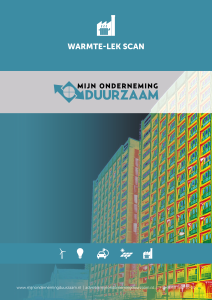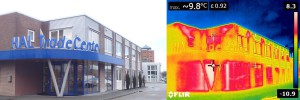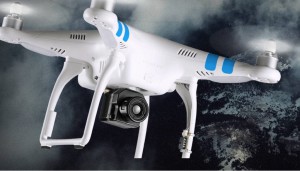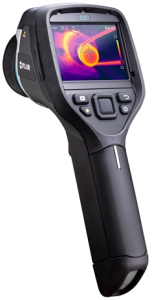Why should you get a thermal image of your building?
A thermal image identifies where your company building is leaking heat, and where it would pay off to install extra insulation. Good insulation is more pleasant, but also healthier: defective insulation (i.e. thermal bridges) can cause an accumulation of moisture and mold in walls, and wood rot in floors and roofs.

Using a thermal imaging camera, the following defects can be detected:
• Lacking insulation
• Wet or worn insulation
• Thermal bridges (in the insulation)
• Cracks, seams and holes
• Construction defects
• Incorrect detailing
• Leakages
Bad insulation can cost an average sized company building up to €10.000 annually. This equates to around 10% of an average company’s total climate charge. Furthermore, a badly insulated company is unpleasant to work in: it always feels draughty.
Contact one of our advisors for a non-binding introductory meeting.
Do you need a Heat Loss Scan?
Our Heat Loss Scan can be interesting to any company in order to provide a first impression of unnecessary energy loss of the building.
A heat loss survey can give valuable information about the location of heat leakages and identify possibilities for better insulation. This can be helpful for example when renovating the building, especially when the history of the building is not fully known, or when you are wondering whether old insulation measures are still intact.
How does a Heat Loss Scan work?
We use a special thermal imaging camera to carry out the heat loss scan. This camera visualizes infrared heat. The camera contains a so-called microbolometer, which heats up with infrared radiation. The differences in temperature are converted into electrical voltage, which then is transformed into an image. Most cameras use the color blue to indicate coldness and red to indicate heat.
In order to make a good thermal image, you need a temperature difference of at least 10 degrees Celsius (or 50 °F) between in- and outside. There cannot be any disruption of sun-rays or rainfall. That is why it is best to carry out the scan during winter after sunset, or on a cloudy day.
An expert can see what you can’t!
Setting up a thermal imaging camera and interpreting its images require craftsmanship. The colors on the thermal image are not unequivocally related to heat loss from your facade or roof. For example, brick and aluminium look very different under the same temperature. These factors need to be corrected. Furthermore, translating thermal images to meaningful energy-saving measures requires expertise in engineering and construction.
The advisors at My Sustainable Business possess the necessary skills to interpret heat images correctly.
Large differences between cameras

The specifications of heat imaging cameras vary widely. A cheap camera requires you to take a photo of the facade at a distance which is the same as the its height (optical relation 1:1).  More expensive models come with an optical relation of 1:50, which enables a larger amount of detail (even from a large distance).
More expensive models come with an optical relation of 1:50, which enables a larger amount of detail (even from a large distance).
Thermal sensitivity is another important measure of the temperature differences that can be visualized by the camera. At 100 mK (milliKelvin) you can detect differences of 0,1 degrees Celsius.
My Sustainable Business uses extremely sensitive FLIR thermal imagining cameras (type E60).
Downloads:
Brochure Heat Loss Scan
